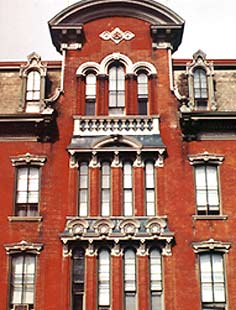
 |
||||||




"Accepted practices of historic preservation provide the theoretical foundation for the guidelines." Noré V. Winter, Developing Design Guidelines for Historic Districts, 1993
A firm foundation. The work we do today in our historic neighborhoods and on local landmarks is firmly connected to accepted historic preservation principles and practices of 19th century Europe. From the past, we inherit the idea of a hierarchy for work, from the "least intervention to the greatest." These are a few of the well-known ideas. We "maintain rather than repair." We "repair rather than replace." We "preserve rather than restore." We "restore rather than reconstruct."
Development of Federal Standards in the '70s. Based on accepted principles and practices, the National Park Service created The Secretary of the Interior's Standards for Historic Preservation Projects. This document contained general Standards for all projects and specific Standards for acquisition, protection, stabilization, preservation, rehabilitation, restoration, and reconstruction. The early Standards were used to measure the appropriateness of project work where federal grant-in-aid funds were sought. Also in the 70s, the Standards for Rehabilitation were singled out as requirements for a brand new federal program that offered a 20% tax credit for certified rehabilitation work—the Federal Preservation Tax Incentives Program. By adopting the Standards in regulation, the federal government made them requirements for those programs.
Ongoing use in the '80s and '90s. During two decades of ongoing use within the NPS' Federal Preservation Tax Incentives and Grant-in-Aid Programs, the Secretary's Standards were updated with public input to keep pace with the times. The Standards for Rehabilitation were revised in 1990 through their adoption in regulation (36 CFR 67) for the Tax Incentives Program. The Secretary of the Interior's Standards for Historic Preservation Projects were revised in 1983 and again 1992, when they were re-named The Secretary of the Interior's Standards for the Treatment of Historic Properties through their adoption in regulation as 36 CFR 68. They remain in use today within the HPF Grant-in-Aid Program.
Into the 2000s. Without a doubt, Rehabilitation is the most frequently applied approach to work in our nation's communities today and the Federal Preservation Tax Incentives Program is as popular as ever. But the Standards for Rehabilitation have tended to overshadow the more inclusive conceptual package, The Secretary of the Interior's Standards for the Treatment of Historic Properties. The Standards for Rehabilitation are often applied where the project goal is Preservation or Restoration. If a historic district applies work other than Rehabilitation—in particular, Restoration—then other Standards should be considered, adopted, and applied as well. Read on to learn more about the basic differences between the four treatments and the importance of choosing the best approach for work in your historic district or on a local landmark!
---------------------------------